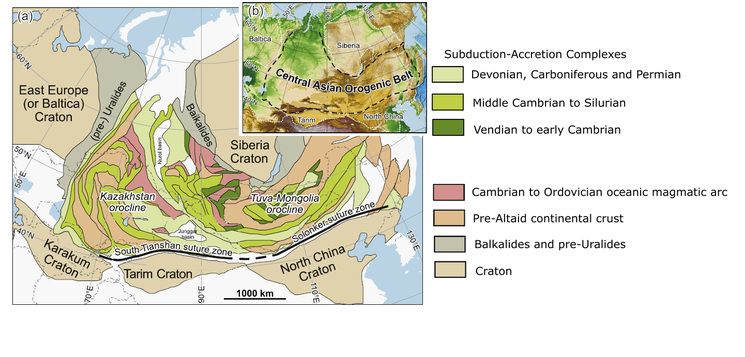Our website is made possible by displaying online advertisements to our visitors.
Please consider supporting us by disabling your ad blocker.
Central Asian Orogenic Belt
The Central Asian Orogenic Belt (CAOB), also called the Altaids,[1][2] is one of the world's largest Phanerozoic accretionary orogens,[1][3] and thus a leading laboratory of geologically recent crustal growth.[4] The orogenic belt is bounded by the East European Craton and the North China Craton[1] in the Northwest-Southeast direction, as well as Siberia Craton and Tarim Craton in the Northeast-Southwest direction.[1] It formed by ocean closures during Neoproterozoic to the late Phanerozoic time,[5] from around 750 to 150 Ma.[2] Like many other accretionary orogenic belts, the Central Asian Orogenic Belt consists of a huge amount of magmatic arcs, arc-related basins, accretionary complexes, seamounts, continental fragments and ophiolites.[1][3] It is also considered a relatively distinctive collisional orogenic belt because widespread subduction-accretion complexes and arc magmatic rocks can be found in the region, but collision-related foreland basins are not common.[1]
The formation history of the Central Asian Orogenic Belt is complex and highly disputed among academic scientists. Currently, there are two major evolutionary hypotheses that could potentially explain the geological history of the Central Asian Orogenic Belt.[3] One of the hypothesis stated by geologist Celal Sengor proposed that the Central Asian Orogenic Belt formed due to the accretion of multiple oceanic arcs and continental crusts, while another hypothesis proposed that it was produced by accumulating subduction-accretion complexes on a magmatic arc.[3]
The Central Asian Orogenic Belt is now one of the most researched orogenic belts in the world due to its high significance in researching continental accretion and ore formation.[1] It contains plentiful natural resources, including mineral ores, oil and gas. These rich mineral resources explain why the Central Asian Orogenic Belt is also called the Central Asian metallogenic domain, which is one of the largest metallogenic domains in the world.[1]

- ^ a b c d e f g h Xiao, Wenjiao; Song, Dongfang; Windley, Brian F.; Li, Jiliang; Han, Chunming; Wan, Bo; Zhang, Ji’en; Ao, Songjian; Zhang, Zhiyong (January 2020). "Accretionary processes and metallogenesis of the north Central Asian Orogenic Belt: Advances and perspectives". Science China Earth Sciences. 63 (3): 329–361. Bibcode:2020ScChD..63..329X. doi:10.1007/s11430-019-9524-6. ISSN 1674-7313. S2CID 210122897.
- ^ a b Şengör, A. M. Celal; Sunal, Gürsel; Natal'in, Boris A.; Van der Voo, Rob (May 2022). "The Altaids: A review of twenty-five years of knowledge accumulation". Earth-Science Reviews. 228: 104013. Bibcode:2022ESRv..22804013S. doi:10.1016/j.earscirev.2022.104013. S2CID 247905844. Retrieved 17 December 2022.
- ^ a b c d Safonova, Inna; Seltmann, Reimar; Kröner, Alfred; Gladkochub, Dmitry; Schulmann, Karel; Xiao, Wenjiao; Kim, Juyong; Komiya, Tsuyoshi; Sun, Min (September 2011). "A new concept of continental construction in the Central Asian Orogenic Belt". Episodes. 34 (3): 186–196. doi:10.18814/epiiugs/2011/v34i3/005. ISSN 0705-3797.
- ^ Kröner, Alfred (2015). The Central Asian Orogenic Belt : geology, evolution, tectonics and models. Borntraeger Science Publishers. ISBN 978-3-443-11033-8. OCLC 910103233.
- ^ Wilde, Simon A. (November 2015). "Final amalgamation of the Central Asian Orogenic Belt in NE China: Paleo-Asian Ocean closure versus Paleo-Pacific plate subduction — A review of the evidence". Tectonophysics. 662: 345–362. Bibcode:2015Tectp.662..345W. doi:10.1016/j.tecto.2015.05.006. ISSN 0040-1951.
- ^ a b Han, Yigui; Zhao, Guochun (November 2018). "Final amalgamation of the Tianshan and Junggar orogenic collage in the southwestern Central Asian Orogenic Belt: Constraints on the closure of the Paleo-Asian Ocean". Earth-Science Reviews. 186: 129–152. Bibcode:2018ESRv..186..129H. doi:10.1016/j.earscirev.2017.09.012. ISSN 0012-8252. S2CID 134624421.
- ^ Cite error: The named reference
:2was invoked but never defined (see the help page).
Previous Page Next Page


